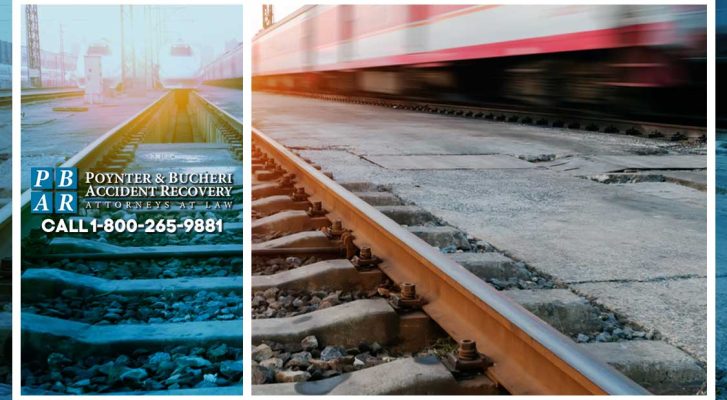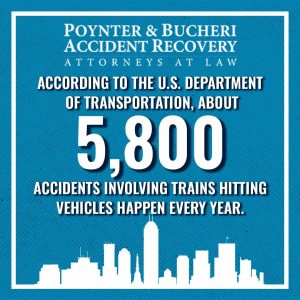
Car Getting Hit By a Train: Who’s Liable?

Individual railroads are all held to strict standards and bound by federal regulations to create and maintain a safe place for cars to cross railroad tracks.
The reason is clear: Thousands of pounds of freight moving at high speeds spell disaster for much smaller cars and their drivers. That’s why railroad crossings are often marked with lights, sounds, and even gates to warn drivers of an oncoming train.

However, even with all the regulations in the world, accidents happen. According to the U.S. Department of Transportation, about 5,800 accidents involving trains hitting vehicles happen every year, with about one collision every 3 hours.
But when an incident of a car getting hit by a train occurs, who’s liable for that incident from a legal perspective? The railroad? The city? The driver?
Liability can be tricky in such cases, and the answer depends on a variety of factors. In this article, we will explore just some of these that come into play when figuring out liability in a car train accident.
The Basics of a Train-Car Collision
Train-car collisions can be devastating events, and the result can be much more than just car damage. According to the Federal Railroad Administration, train-car collisions resulted in 274 railroad crossing fatalities and 812 crossing injuries in 2022 alone, with the majority of these occurring in Texas, California, and Illinois.
Train-car collisions occur for varying reasons. Some of the major reasons include:
Driver Negligence
Drivers can be the cause of the collisions by ignoring warning signs at the crossing or attempting to beat a closing gate. These types of accidents can also occur due to distracted or impaired driving.
Train Operator Error
All train operators are required to follow strict rules and regulations when it comes to operating a train. Errors on their part, like not applying the brakes on time or failing to sound the horn upon approach can result in collisions.
Malfunctioning Railroad Equipment
While there are strict rules and regulations when it comes to maintenance and safety inspections for railroad equipment, it can still malfunction. Some common equipment failures include defective crossing gates and malfunctioning signals.
Poor Maintenance
Inadequate road maintenance, track maintenance or signal systems can often lead to accidents involving trains and vehicles.
Car Getting Hit by a Train: Who Is Liable?
When it comes to train-car collisions, liability can be a bit complicated.
In the end, liability really depends on the answer to the big question: Who was negligent?
Several parties may be involved in the collision, so a thorough investigation will be necessary to ensure liability is being placed on the correct party. Here is how key parties may be held liable:
Driver of the Vehicle
The car’s driver may be held liable if the investigation reveals that their negligence or reckless behavior contributed to the accident. Common ways a driver may be negligent or reckless include ignoring the crossing’s warning signals, trying to beat the train by crossing when it’s too close to brake, being distracted while driving and not seeing or hearing the warning signals, or being impaired while driving including driving while intoxicated.
Train Operator or Railroad Company
Liability can fall on the train operator or overall company if the investigation finds that there was negligence or failure to follow the strict safety restrictions they must operate under. This could be an error in operating the train, failure to sound the horn or apply the brakes in a timely manner, or violating any other safety regulations as laid out by the Federal Railroad Administration and other governing agencies.
Manufacturers
If a collision was due to defective equipment, the manufacturer of that piece of equipment can also be held liable. This includes manufacturers of railroad crossing gates, warning signals, and other mechanisms involved in keeping trains and vehicles safe.
Finally, there could be a collision that shows contributory negligence. This type of negligence means there was more than one party involved and the legal liability is shared amongst them. For example, a train operator may have been found to be negligent by ignoring an important safety protocol while the driver simultaneously was exhibiting distracted driving. In this case, liability could be apportioned based on each party’s degree of fault.
Let Our Indianapolis Personal Injury Attorneys Help You
While all car collisions can be scary and devastating, a car getting hit by a train can be especially so. That’s why it’s important for you to know that if you are involved in such a situation, you don’t have to go through it alone.
The car accident attorneys at Poynter and Bucheri have years of extensive experience dealing with car collisions of all types and know what happens if you get hit by a train. They know how to get you the settlement you deserve. If you’ve been in a collision and need help getting a settlement to get your life back on track, contact us today to take advantage of our free case review-1-800-265-9881.
